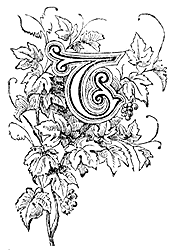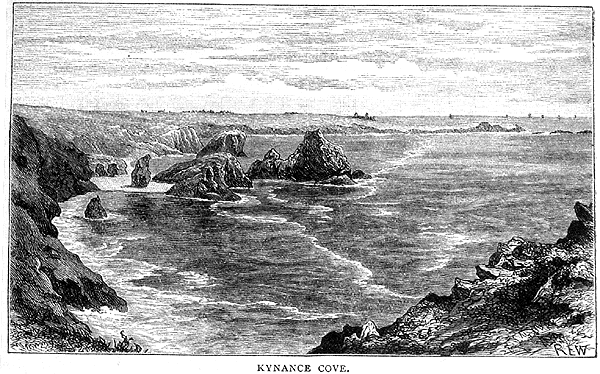
Of all its coves, however, Mullion is perhaps one of the prettiest. A pathway down the hill brings us to a hollow dividing the lofty crags that breast the ocean, and we are near some fishers' dwellings. Within a few yards of the land rises a rocky pyramid, and in front of the glen is an island; to the left a range of cliffs of the exquisite serpentine, - a species of rock found only in Cornwall, Wales, and Scotland, but nowhere else in England. There is a cave in these cliffs that is of some extent, and was probably in old days a resort and hiding-place of smugglers, who were rather abundant in this wavewashed county, which had also an evil reputation of being the abode of wreckers. There were many smugglers' caves or holes on the banks of the Helford river, and several have been discovered on the coast about St. Keverne by the falling in of their roofs. In one near Penzance a skeleton was discovered with its clothes on, lying beside two or three kegs of spirits. Of these smuggers there was, during the close of the last century, a native of Breage named Carter, who was called the King of Prussia from some fancied resemblance to the Great Frederick, whose name at one time was a household word in England. This man became the leader of the Cornish smugglers. He chose for his home and his smuggler's hold a rocky cove about two miles east of Marazion, which still bears the name of Prussia Cove, where his gang cut deep channels in the hard rock, which are still visible, to allow of the near approach of their boats. The "King of Prussia" was exceedingly clever at avoiding the excise officers, always removing his stores in time. Amongst them were some old cannon, the possession of which probably induced Carter to run the risk that might have brought him to de struction. From the cliffs one moonlight night he watched his boats approaching the landing-place laden with a rich booty of smuggled goods, but at the same moment appeared the revenue cutter Fairy under all sail in swift pursuit, for her crew had also distinguished them. The king's vessel gained rapidly on the boats. The old smuggler stood gazing anxiously at the chase. Then with sudden determination he bade the men with him "fire the guns." They had been placed at the edge of the cliff, loaded, and were discharged at the cutter, which could not elevate her guns high enough to reply, and was obliged to sheer of; the boats meanwhile landing. Of course early dawn saw the white sails of the cutter again off the cliffs, and the captain and his crew landed, and mounted the hill. There was no sign of cannon there now! The officer went to Carter's house for an explanation, and was met by the smuggler, who at once attacked him about "practising the cutter's guns at midnight, and disturbing the neighbourhood," utterly denying all knowledge of the firing himself. No evidence of who had fired the cannon on the cliff could be obtained, though the smuggler was well known, and the matter was let drop. Carter, however, did not prosper to the end of his career, and was at last detected and punished. He died at a great old age, a very poor man. 1. The ranges of cliffs south of Mullion are very fine, and there are two pretty coves in them. Vellan Head is especially grand, with the sea breaking at its base, to which it is impossible to descend from the top on the seaward side. Passing the crags called the Fill we at length reach the loveliest cove on this part of the coastKynance. Here the cliff wall is much broken; there are rocks scattered in the water near the shore, and small islands; between them and the sandy shore is a tall rock called the Steeple; to the south an island called the Lion Rock. The spot is as wild as it is beautiful, and only a few fishers' cottages are to be seen to prove the presence of man. The islands can be reached from the shore on foot at low water by crossing the sand, on which are cast great boulders of rock. The caves of serpentine are well worth exploring, but at high tide the sea intervenes between the island and the land, and renders a visit to the caves impossible. Sometimes it is smiling and tranquil; at others rushing in and dashing in fury against the cliffs. One of the "sights" or wonders of Kynance are the rocks called the Post Office and the Bellows; they may be seen at half-tide on the landward side of Asparagus Island, a few feet above its base. The upper one is an orifice or slit. A sheet of paper must be held before it, from the side; a sudden gust of air at once carries it away into the slit, and then in less than a minute, with a loud roar, a burst of water issues angrily from the hole-the answer to our letter! This singular effect is said to be caused by the action of the waves beating against the now slight wall of rock, and the draught caused when they fall back. The Bellows Rock is below the Post Office, and also at intervals sends forth a sudden jet of water. * * * * * * 1. This incident is told on the authority of Mr. Hunt, who heard it on the spot. |
||||

